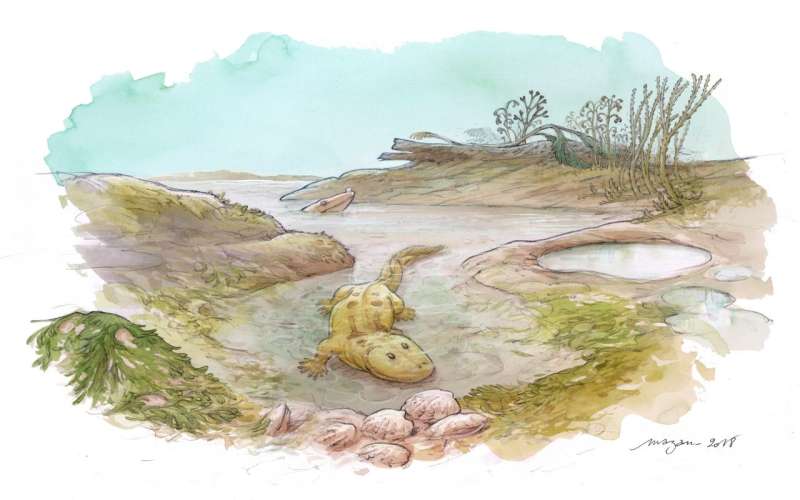Credit: Nature (2018). DOI: 10.1038/s41586-018-0159-2
A team of researchers from several institutions in France and China has found evidence that some of the earliest creatures to walk on land likely emerged from estuaries or deltas. In their paper published in the journal Nature, the group describes studying certain stable isotopes in fossil specimens to determine the salinity in which they lived.
Back in 1929, a team of researchers discovered the fossilized remains of Ichthyostega, a tetrapod that was believed to be among the first creatures to walk on land. Since that time, similar types of remains have been found in places like Greenland and China. Study has shown the creatures were able to live both on land and in water—they had four legs, tails for swimming and gills. But until now, scientists reported difficulty in figuring out if the water they came from was fresh or salty (suggesting an ocean existence). In this new effort, the researchers tested 51 ancient fossilized tetrapod bones as a new way to find the answer to this question.
The team studied sulfur and oxygen isotopes. Seawater has more sulfur-34 compared to sulfur-32 than freshwater. Since both wind up in the bones of creatures that live in water, the researchers studied the ratios in the fossilized bones. They found that the ratios fell closer to seawater. But in studying oxygen isotopes, they found that the creatures were also exposed to freshwater. The evidence suggests that the tetrapods lived part of the time in seawater and part of the time in freshwater. Such places today include estuaries and river deltas. To further bolster their theory, they tested modern creatures that live in such places and found a near match.
Adding to the story, the fossilized remains have been dated back to approximately 365 million years ago, which was towards the end of the Devonian Period—just prior to the mass extinction of ocean dwelling creatures. The ability to live in both fresh water and sea water, the researchers note, would have given the tetrapods a leg up, so to speak—they would have been able to survive in both types of water and sometimes on land.
More information: Jean Goedert et al. Euryhaline ecology of early tetrapods revealed by stable isotopes, Nature (2018). DOI: 10.1038/s41586-018-0159-2
Abstract
Early tetrapods—the first four-footed vertebrates to truly walk on land—lived in variably salty waters such as those found in estuaries, according to a study published in Nature this week.
Although famous for emerging onto the land, tetrapods were primarily aquatic, with gills and a powerful tail for swimming. The type of water they lived in, however, has been heavily debated. The first fossils were found in sandstones initially thought to have been deposited in freshwater. However, the discovery of tetrapod remains and trackways in sediments derived from brackish (slightly salty) water and from seawater suggest that early tetrapods may have been able to tolerate varying salinities.
Jean Goedert and colleagues analysed 51 early tetrapod fossil specimens alongside associated armoured and lobe-finned fish, found in rocks from the Devonian Period (around 365 million-years ago) of northwest China and east Greenland. Using new methods that enable the measurement of isotope ratios from sulfur as well as carbon and oxygen,the authors could distinguish freshwater animals from their marine counterparts.
After demonstrating their sulphur isotope approach on modern vertebrates, including crocodiles, red-eared terrapins and various fish, the authors determine that the fossil tetrapods and other vertebrates they studied lived in environments that had a mixture of fresh and seawater—such as is found in estuaries and deltas. The authors conclude that it is therefore likely that tetrapods could cope with varying levels of brackishness. This versatility may have helped them survive the extinctions of the Late Devonian, before going on to colonize the land.
Journal information: Nature
© 2018 Phys.org
























